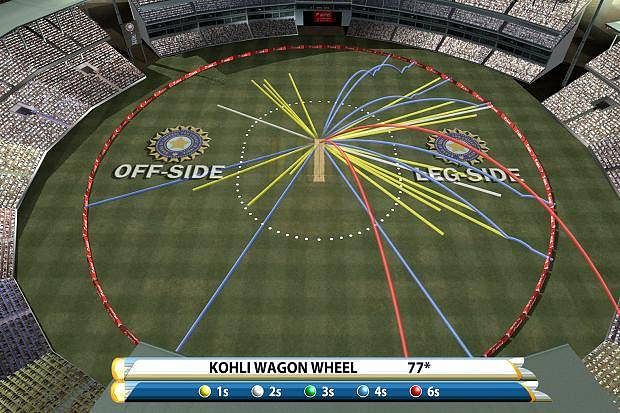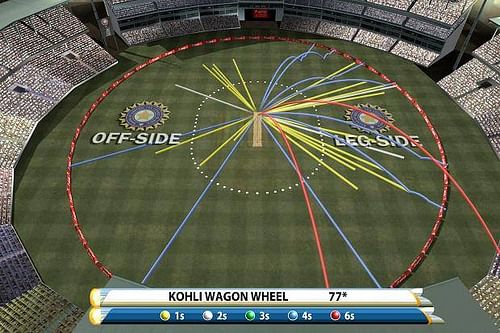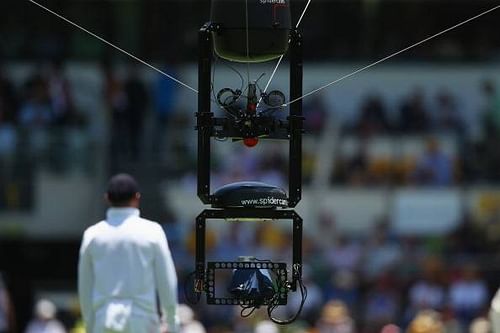
Inventions that changed cricket on TV

Long gone are the days when BBC (cricket broadcasters for close to eighty years now) used to telecast matches with only two cameras on opposite ends, and a handful of scattered cameramen across the ground. Modern broadcasters provide the conventional coverage with loads more, implementing technology like never before, making more out of the game than just wood and leather.
Providing visual splendor as well as scope for in-depth analysis, these new inventions have changed the way television viewers watch cricket. They also make the game appealing for the casual cricket follower.
The Traditional ones:
Speed Gun:
The text flash at the bottom of the scorecard providing the speed of each delivery is courtesy of the SpeedGun. The technology, which was first introduced in 1999, calculates the speed of a bowler’s delivery by using a machine fixed on a pole next to a sight screen. The machine detects movements across the length of the pitch by relaying a beam from atop the pole.
Fast bowlers have made it the conveyor of their speeding prowess, with Brett Lee, Shoaib Akhtar and Shaun Tait famously smashing the 100 mph speed barrier in recent times.
Wagonwheel:
The Wagonwheel provides a two-dimensional representation of the various shots that a batsmen has played, categorized by the value of each. Singles, Two’s, Three’s, 4’s and 6’s are displayed over virtual grounds to give a sneak peek into the various areas that a batsman has targeted over the course of his knock.
Pitch Maps and Beehives: These colorful representations capture the length of each delivery on the pitch, as well as the point of impact of the ball on the bat. Each color represents the number of runs scored off the delivery. Over the course of the innings, they give an analysis of the areas in which particular bowlers have bowled.
StumpCam:
The Stump camera is one of the many innovations with the camera in cricket. A small camera is placed inside a hollow stump, preferably the middle one, and it sends live feedback to the broadcasters. It provides a unique view to the viewers, also giving hazy yet crucial replays for reference in case of close stumping or run out chances. The sight of a whizzing yorker blacking out the feed is also an entertaining one.
Reaction Time:
This technology calculates the time the ball took to travel from the hand of the bowler, or how much time a fielder got to react to a chance. The feature gives slow motion replays with the calculated result, accentuating the effect of a catch or a fielding effort.
HawkEye:
The dispeller of doubts, HawkEye is a graphical representation of the trajectory of a delivered ball.
Using six to seven cameras that capture the path of the moving ball, it estimates the ball’s projectile after the point of impact, helping the Umpires decide on close LBW calls, as well as provide the viewer with a closer look of the different variations that a bowler delivers. It was introduced in 2001 with the aim of making TV viewing more dynamic and interactive.
Snickometer:
The Snickometer is an umpire’s assistant in capturing faint edges and bat-pad instances. Using highly sensitive microphones that are placed at the base of the stumps, an oscilloscope detects the faint noises that are associated with edges. Imposing the real-time video with the captured sounds, a graph generates the disturbances, helping differentiate edges from false alarms.
The latest additions:
Hot Spot:
Introduced during the 2006-2007 Ashes, the Hot Spot is a thermal technology that uses infra-red imaging to detect if the ball has made contact with the bat. Using infrared cameras that are placed across the stadium, a change in the heat signature of the ball is detected. The friction generated by the ball on the bat shows a bright spot on the negative.
SpiderCam:

The latest and the one of the most unique inventions involving the camera, the SpiderCam captures unprecedented images from across the length and breadth of the stadium.
Four winches are placed at opposite corners of the ground, with each controlling a Kevlar cable to move the central camera (dolly) across the stadium. The movement can be both horizontal and vertical, adept at tracking the movement of the ball from close quarters, as well as dropping down to base height to mimic a player’s vision during a match.
HatCam:
The umpire’s monotonous job has been given a twist with the quirky invention of the HatCam. A GoPro camera is placed atop an umpire’s hat, giving real time and first-hand vision of LBW appeals. The conversations of the players with the umpire, all caught on camera, make for an interesting sight.
LED Stumps and Bails:
This modern gimmick, backed by a solid electronic system, makes the conventional wooden stumps look obsolete. As soon as the ball strikes the stumps, the LED inside the bails and stumps glow up in unison, providing an instantaneous solution to the confusing rule of dislodged bails during a run-out. Created by Zing International, the entire set is very expensive, with the stumps costing Rs. 24 Lakh, and each pair of bails costing half a lakh rupees.
Controversies:
Although helpful in eliminating errors and providing breathtaking visuals and insights, these inventions have also been embroiled in controversies in recent times:
The use of the DRS system, which implements the HawkEye and Hot Spot to review decisions, has been controversial during important events such as the Ashes and the World Cup, providing indifferent results leading to debatable decisions. There were rumours that some batsmen had been using silicone tapes on their bats in a bid to evade the detection of edges on the HotSpot. It was axed for the 2013-14 Ashes amidst mixed reactions from current and former players.
The SpiderCam was caught in a web of controversy earlier this year, when Australian captain Steven Smith blamed the contraption’s cables for a crucial dropped catch against India. The camera, which is generally retracted when a delivery is bowled, allegedly hindered the natural movement of the ball when Smith positioned himself for the catch.
With such a strong influence of technology, even the impulsiveness of celebrating victory has to follow protocol now. MS Dhoni, a fan of collecting stumps as a souvenir after each victory, has strict instructions not to do the same with the expensive set of LED stumps.
With each new gadget comes a long drawn debate about technology's increasing imprint on the game. The game involving a red cherry and white flannels might have evolved into a more commercial entity, but the controlled use of technology might indeed drive the game forward, helping it come to terms with the digital age we now live in.